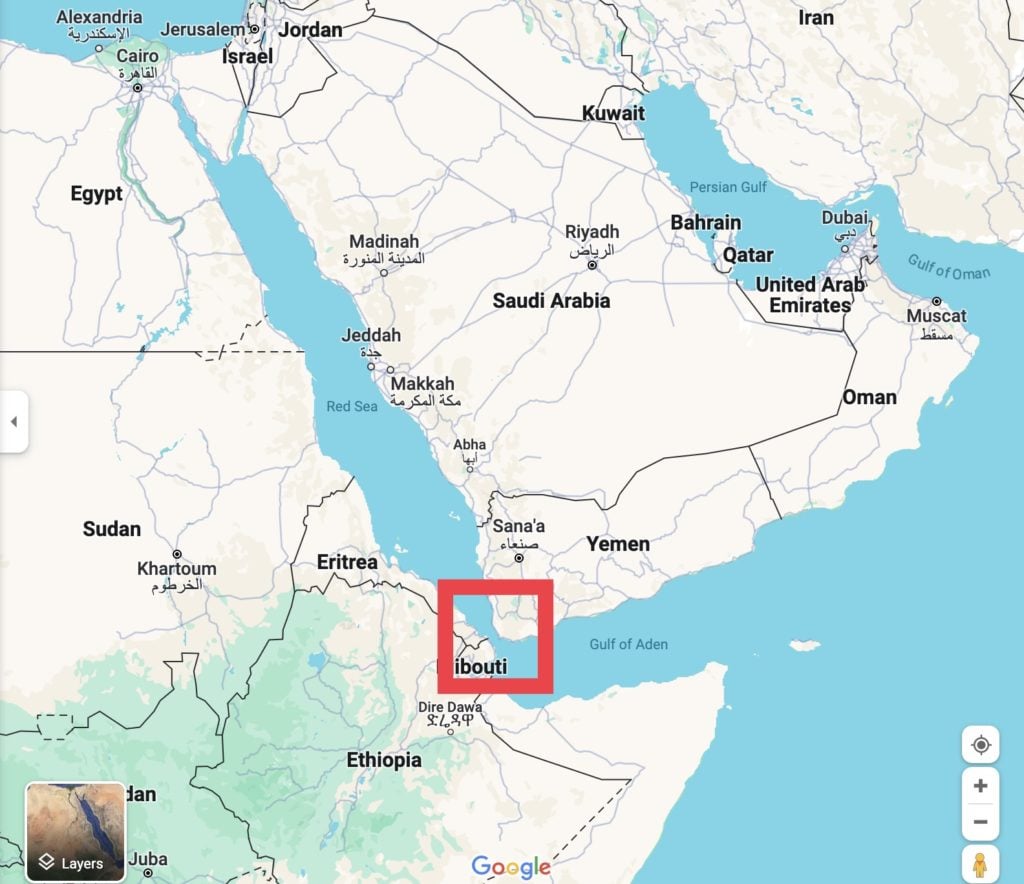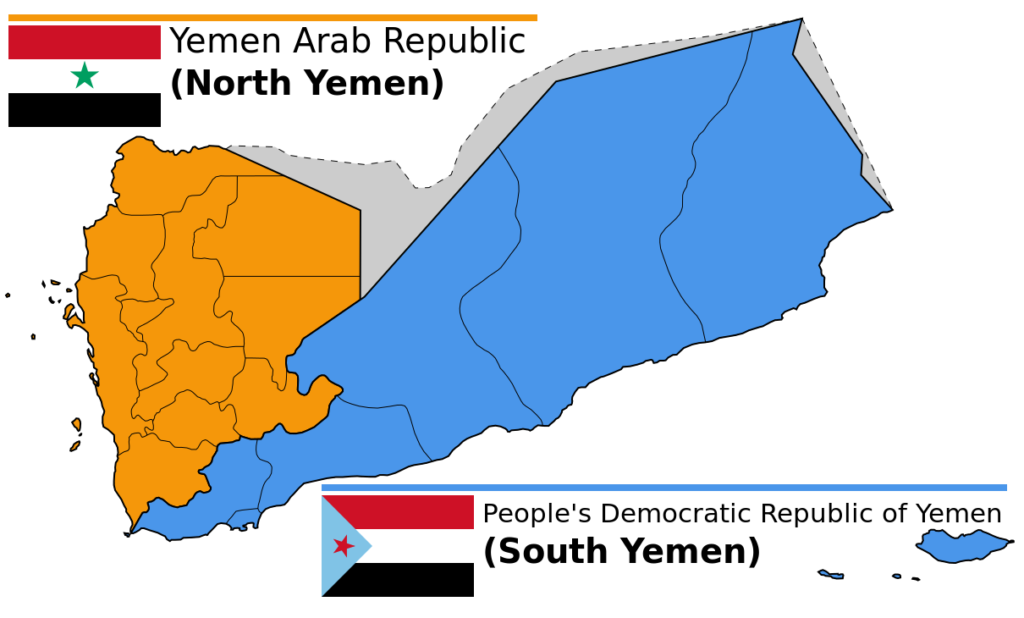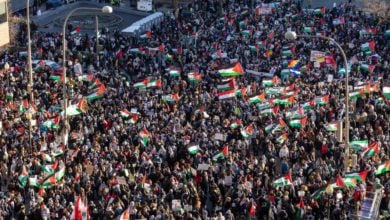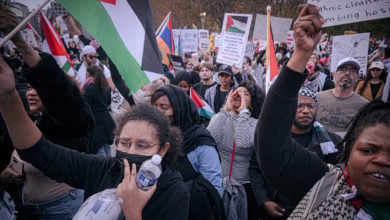Photo: Map of Bab-el-Mandeb Strait, where the Houthis (officially known as Ansar Allah) have been conducting attacks on ships.
You may have seen the headlines: The Houthis, a Yemeni resistance group, have been attacking Israeli-linked ships going through the Red Sea in solidarity with the Palestinian people’s struggle for liberation. Strategically located at the rainy, southern end of the Arabian Peninsula, with a deep water port in Aden, Yemen controls the Bab-el-Mandeb at the southern end of the Red Sea. This narrow passage from the Red Sea to the Gulf of Aden and the Arabian Sea is an important maritime path connecting the Mediterranean Sea to the Arabian Sea.

Map showing the Bab-el-Mandeb Strait.
Significance of the Bab-el-Mandeb
The Bab el-Mandeb Strait is an important chokepoint in the maritime trade route between the Indian Ocean and the Mediterranean Sea via the Suez Canal. The strait is crucial for the transport of crude oil and fuel from the Gulf, as well as commodities headed to Asia. In fact, around 7.80 million barrels of crude and fuel shipments were transported through the strait in the first 11 months of 2023.
As a result of the attacks, “major shippers including Hapag Lloyd, MSC and Maersk, oil major BP and oil tanker group Frontline have said they will be avoiding the Red Sea route and re-routing via the Cape of Good Hope for the time being.” This means ships are now traveling all the way around Africa.
On Dec. 19, the Pentagon announced it had convened Operation Prosperity Guardian, “an important new multinational security initiative”, to counter the Yemeni actions, threatening an expanding regional war in defiance of the global consensus for a permanent Israeli ceasefire.
Mohammed Abdel-Salam, the Houthis’ chief negotiator and spokesman responded on X, formerly known as Twitter: “The American-formed coalition is to protect Israel and militarize the sea without any justification, and will not stop Yemen from continuing its legitimate operations in support of Gaza.”
Abdel-Salam added that the Houthis’ attacks “are not a show of force nor a challenge to anyone,” saying, “Whoever seeks to expand the conflict must bear the consequences of his actions.”
Yemen’s solidarity with Palestine
As early as Oct. 10, the Houthis had warned they would take military action in solidarity with Gaza if the United States were to intervene directly. Houthi leader Abdel-Malek al-Houthi warned the United States early on that if it directly intervened in Gaza, the group would resort to military options, such as firing missiles and drones.
Between Oct. 31 and Dec. 12, the Houthis claimed a number of attacks on Israeli-linked ships in the Red Sea, announcing in November, “All ships belonging to the Israeli enemy or that deal with it will become legitimate targets.”
Then after striking three commercial ships in early December, Houthi military spokesman Brigadier General Yahya Saree said, “The Yemeni armed forces continue to prevent Israeli ships from navigating the Red Sea (and Gulf of Aden) until the Israeli aggression against our steadfast brothers in the Gaza Strip stops. The Yemeni armed forces renew their warning to all Israeli ships or those associated with Israelis that they will become a legitimate target if they violate what is stated in this statement.”
On Dec. 12, Saree announced in a statement that the Houthis had struck a Norwegian commercial tanker with a missile. The tanker was on its way to deliver crude oil to an Israeli terminal.
When you look at the coverage of what’s happening in the Red Sea, it can be confusing. Some coverage will say that the ships are being blocked by Yemen’s military, other coverage says it’s being done by a rebel group, the Houthis. Pretty much all mainstream media coverage echoes the U.S. government’s assertion that the Houthis are backed by Iran or act as a proxy for Iran. Who are the Houthis? Are they puppets of Iran? Are they rebels, or do they represent the government of Yemen?
It’s hard to understand the Houthi movement without a broader understanding of 20th century Yemeni history.
Brief recent history of Yemen
Yemen is a country with a rich historical and cultural heritage including its capital city of Sanaa, one of the oldest continuously inhabited cities in the world. The country is also rich in natural resources, including oil reserves, that are largely unexploited. The Port of Aden in the south of Yemen is a large, deepwater port that can service large vessels.
Due to colonialism, the north and south parts of Yemen developed on different paths during the 20th century.
Britain conquered Aden in 1839 and ruled it directly as a “protectorate” until a Marxist-led anti-colonial movement forced them out in 1967, leading to the founding of the Peoples Democratic Republic of Yemen. This was the first and only Marxist-led government in the Middle East.
In the 1960s, changes were taking place in the northern part of Yemen as well.
Before 1962, North Yemen was known as the Mutawakkilite Kingdom of Yemen and was ruled by a hereditary Imam. In 1962, a group of young military officers led a coup that overthrew the Imam. This led to a civil war between the Republicans — those who wanted a republican form of government instead of a monarchy — and the Royalists.
In the context of the Cold War and the the Pan-Arab movement of the time, this war quickly involved other forces: The Saudis with the backing of the British and and the United States intervened on behalf of the Imam’s forces, while Egypt and the United Arab Republic (now Syria), with support from the USSR, supported the Republican forces. After the Six Day War in 1967, Egypt withdrew its forces and the war ground on to a negotiated settlement.
From a class perspective, the 1962 Revolution in the North represented the forces of modernity, of aspiring bourgeois democracy, attempting to smash and take over from the forces of feudalism, as represented by the Imam and the rural tribal leaderships. However, the civil war ended up without the feudal elements in the countryside being decisively smashed. Instead, the Saudis started a system of financial support for the rural tribal leaders.

A map of Yemen divided between North and South. Credit: Wikipedia.
Feudalism in rural Yemen
When we say “tribal” it may conjure up all sorts of images. In the case of Yemen, this is a system of feudalism in the rural areas where the leaders own and/or control the land and live in relative ease and wealth and the other tribal members live in poverty. Rank and file tribesmen live under the “protection” of the leaders and also often function as informal armed forces, deployed in conflicts with other tribes or with the central government.
Thus this feudal system continued on after the Revolution of 1962 — true land reform never occurred. The new central government in the North was able to bring some improvements to the people, especially with the support of the socialist bloc: public health campaigns, such as vaccinations; more access to education and a significant increase in literacy rates; the electrification of many areas; and an increase in paved roads. But it’s important to understand that the rural areas continued to be more under the control of the tribal leadership than of the central government, and that the vast majority of those living in these areas continued to experience significant poverty.
In 1990 as the socialist bloc was crumbling internationally, North and South Yemen moved to unify. In 1994, the formerly socialist southern part of Yemen attempted to secede, leading to a civil war and reunification under a definitively pro-capitalist model with neoliberal reforms and austerity measures.
It is in this historical context the Houthi movement, officially known as Ansar Allah, evolved.
The Houthis come from the province of Saada in the northernmost part of Yemen, along the border with Saudi Arabia. Cleric Hussein Badreddin al-Houthi began organizing against the central government headed by President Ali Abdullah Saleh as well as grievances with neighboring Saudi Arabia.
History of the Houthi movement up until today
One thing to understand about the Houthis is that they are Zaydi Shia. This is a sect of Shia Islam that is only practiced in Yemen. About 35% of the population are Zaydis. That the Houthis are Shias as are the Iranians is used as evidence that they are puppets or proxies of Iran — a charge which has been denied by both the Houthis and the government of Iran.
That the Houthis started as a Zaydi movement has also been used to accuse them of wanting to revive the monarchy since the Imamate that was overthrown in the 1961 revolution was Zaydi. Ironically, as we have seen, the (Sunni) Saudi government intervened on the side of the Zaydi Shia Imam in the 1960s against the anti-monarchy movement.
The Houthis have a history of conflict with the central government over issues of funding and a desire for greater autonomy. Hussein Badreddin al-Houthi was a Zaydi cleric and member of the Yemeni parliament from 1993 to 1997. In the early 1990s, he started the Believing Youth movement to revive Zaydiism. He began organizing against the central government headed by President Ali Abdullah Saleh. He believed Saleh’s government was too close to the United States, Saudi Arabia and Israel. By the early 2000s, he began rallying supporters for anti-government demonstrations around economic conditions.
In 2004, the government offered a bounty for al-Houthi’s arrest after his followers began fighting with government forces. Al-Houthi was killed in 2004. Fighting between the government and the Houthis continued for years. In 2009, the government declared Operation Iron Fist against the Houthis creating a humanitarian crisis. Saudi Arabia bombed sites in Saada while the Houthis crossed the border into Saudi Arabia. Fighting between Houthi forces on one side and Yemeni government and Saudi forces on the other continued until a ceasefire was signed in early 2010.
In 2011, the Arab Spring protests erupted in Yemen, calling for Saleh to step down on charges of corruption. The Houthis joined in with other Yemeni opposition and civil society sectors. The protests led to Saleh’s resignation in November 2011. His vice president, Abdrabbuh Mansur Hadi, took over with lukewarm popular support. He then won an uncontested election in 2012. The plan was for a new constitution to be drafted with new presidential and parliamentary elections to follow. However, this process was not progressing very well and was unpopular with many constituencies.
The Houthis then began consolidating their forces and territories. They started their drive south to the capital in the context of a developing four-way civil war between the followers of what had been the central government headed by Saleh, socialist-oriented secessionists from the former Peoples Democratic Republic of Yemen, Al-Qaeda in the Arabian Peninsula, as well as the Houthis.
The presence of AQAP in Yemen is a direct result of the Washington’s interventions in Afghanistan and Iraq, going back as far as its support for Osama Bin Laden’s anti-Soviet “mujahedeen” forces in Afghanistan in the 1980s, which included Yemeni volunteers who later returned home.
In September 2014, the Houthis arrived in the capital of Sanaa. Initially functioning in a sort of caretaker role, they eventually took over the presidential palace. Hadi and his government resigned on Jan. 22, 2015, and left for Aden, and the Houthis declared themselves in charge with a five-member presidential council.
Hadi then revoked his resignation and the Houthis continued their drive south from Sanaa to Aden and began shelling Hadi’s residence. Saudi Arabia, using Pentagon-provided weapons, began launching airstrikes against Yemen on March 26, 2015, at Hadi’s request. The Houthis remained defiant.
“Our fighters will not evacuate from the main cities or the government institutions,” Houthi leader Abdul-Malik al-Houthi said on April 19, 2015. “Anyone who thinks we will surrender is dreaming.”
This launched the brutal Saudi war on Yemen, which has led to a horrific humanitarian disaster. By the fall of 2023, fighting had begun to subside and talks were taking place to bring the conflict to a conclusion. The Houthis have emerged as the strongest Yemeni military force that stood up to the U.S.-supported Saudi bombing campaign.
Solidarity with the Palestinian and Yemeni people against U.S. retaliation!
The mainstream media continues to echo the position of the foreign policy establishment in labeling the Houthis as “Iranian-backed rebels,” while calling Hadi the “legitimate” or the “internationally recognized” president-in-exile of Yemen.
It is not for the “international community” to determine the legitimacy of Yemen’s leadership. It is hard to believe that most Yemenis would recognize the legitimacy of Hadi, who invited Saudi Arabia to bomb his own country, leading to a vast humanitarian crisis. The Houthis fought back against the U.S-backed Saudi genocidal bombing and emerged as a significant force. They are taking military action in the Red Sea in solidarity with Palestine. All progressive people should oppose U.S. retaliation against Yemen and stand in solidarity with the Palestinian and Yemeni peoples and support their right to self-determination.
Parts of this article were previously published in this Liberation News piece.





